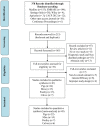Effect of chicken egg yolk antibodies (IgY) against diarrhea in domesticated animals: a systematic review and meta-analysis
- PMID: 24846286
- PMCID: PMC4028221
- DOI: 10.1371/journal.pone.0097716
Effect of chicken egg yolk antibodies (IgY) against diarrhea in domesticated animals: a systematic review and meta-analysis
Abstract
Background: IgY antibodies are serum immunoglobulin in birds, reptiles and amphibians, and are transferred from serum to egg yolk to confer passive immunity to their embryos and offspring. Currently, the oral passive immunization using chicken IgY has been focused as an alternative to antibiotics for the treatment and control of diarrhea in animals and humans. This systematic review was focused to determine the effect of IgY in controlling and preventing diarrhea in domesticated animals including Piglets, Mice, Poultry and Calves.
Methods and results: Previous research reports focused on treatment effect of Chicken IgY against diarrhea were retrieved from different electronic data bases (MEDLINE, EMBASE, SPRINGER-LINK, WILEY, AGRICOLA, MEDWELL Journals, Scientific Publish, Chinese articles from Core periodicals in 2012). A total of 61 studies in 4 different animal classes met the inclusion criteria. Data on study characteristics and outcome measures were extracted. The pooled relative risk (RR) of 49 studies of different animals [Piglets--22; Mice--14; Poultry--7 and Calves--6] in meta-analyses revealed that, IgY significantly reduced the risk of diarrhea in treatment group when compare to the placebo. However, the 95% confidence intervals of the majority of studies in animal class piglets and calves embrace RR of one. The same results were obtained in sub group analyses (treatment regiment--prophylactic or therapeutic; pathogen type--bacterial or viral). Perhaps, this inconsistency in the effect of IgY at the individual study level and overall effect measures could be influenced by the methodological heterogeneity.
Conclusion: The present systematic review (SR) and meta-analysis demonstrated the beneficial effect of IgY. This supports the opinion that IgY is useful for prophylaxis and treatment. However, more intensive studies using the gold standard animal experiments with the focus to use IgY alone or in combination with other alternative strategies are indispensable.
Conflict of interest statement
Figures






Similar articles
-
Intravenous magnesium sulphate and sotalol for prevention of atrial fibrillation after coronary artery bypass surgery: a systematic review and economic evaluation.Health Technol Assess. 2008 Jun;12(28):iii-iv, ix-95. doi: 10.3310/hta12280. Health Technol Assess. 2008. PMID: 18547499
-
Drugs for preventing postoperative nausea and vomiting in adults after general anaesthesia: a network meta-analysis.Cochrane Database Syst Rev. 2020 Oct 19;10(10):CD012859. doi: 10.1002/14651858.CD012859.pub2. Cochrane Database Syst Rev. 2020. PMID: 33075160 Free PMC article.
-
Systemic pharmacological treatments for chronic plaque psoriasis: a network meta-analysis.Cochrane Database Syst Rev. 2021 Apr 19;4(4):CD011535. doi: 10.1002/14651858.CD011535.pub4. Cochrane Database Syst Rev. 2021. Update in: Cochrane Database Syst Rev. 2022 May 23;5:CD011535. doi: 10.1002/14651858.CD011535.pub5. PMID: 33871055 Free PMC article. Updated.
-
Probiotics for the prevention of pediatric antibiotic-associated diarrhea.Cochrane Database Syst Rev. 2015 Dec 22;(12):CD004827. doi: 10.1002/14651858.CD004827.pub4. Cochrane Database Syst Rev. 2015. Update in: Cochrane Database Syst Rev. 2019 Apr 30;4:CD004827. doi: 10.1002/14651858.CD004827.pub5. PMID: 26695080 Updated.
-
Probiotics for the prevention of pediatric antibiotic-associated diarrhea.Cochrane Database Syst Rev. 2011 Nov 9;(11):CD004827. doi: 10.1002/14651858.CD004827.pub3. Cochrane Database Syst Rev. 2011. Update in: Cochrane Database Syst Rev. 2015 Dec 22;(12):CD004827. doi: 10.1002/14651858.CD004827.pub4. PMID: 22071814 Updated.
Cited by
-
Passive Immunization of Chickens with Anti-Enterobactin Egg Yolk Powder for Campylobacter Control.Vaccines (Basel). 2021 Jun 1;9(6):569. doi: 10.3390/vaccines9060569. Vaccines (Basel). 2021. PMID: 34205835 Free PMC article.
-
Evaluating the Protective Role of Intranasally Administered Avian-Derived IgY Against SARS-CoV-2 in Syrian Hamster Models.Vaccines (Basel). 2024 Dec 17;12(12):1422. doi: 10.3390/vaccines12121422. Vaccines (Basel). 2024. PMID: 39772082 Free PMC article.
-
A new passive immune strategy based on IgY antibodies as a key element to control neonatal calf diarrhea in dairy farms.BMC Vet Res. 2020 Jul 29;16(1):264. doi: 10.1186/s12917-020-02476-3. BMC Vet Res. 2020. PMID: 32727468 Free PMC article.
-
Anti-Fel d1 immunoglobulin Y antibody-containing egg ingredient lowers allergen levels in cat saliva.J Feline Med Surg. 2019 Oct;21(10):875-881. doi: 10.1177/1098612X19861218. Epub 2019 Jul 16. J Feline Med Surg. 2019. PMID: 31310154 Free PMC article.
-
Health benefits of orally administered anti-IL-10 antibody in milk-fed dairy calves.J Dairy Sci. 2018 Aug;101(8):7375-7382. doi: 10.3168/jds.2017-14270. Epub 2018 May 16. J Dairy Sci. 2018. PMID: 29778481 Free PMC article.
References
-
- Turner J, Dritz S, Minton J (2001) Review: Alternatives to conventional antimicrobials in swine diets. The Professional Animal Scientist 17: 217–226.
-
- Cromwell GL (2002) Why and how antibiotics are used in swine production. Animal biotechnology 13: 7–27. - PubMed
-
- Kovacs-Nolan J, Mine Y (2012) Egg yolk antibodies for passive immunity. Annual Review of Food Science and Technology 3: 163–182. - PubMed
-
- Moher D, Liberati A, Tetzlaff J, Altman DG (2009) Preferred reporting items for systematic reviews and meta-analyses: the PRISMA statement. Annals of internal medicine 151: 264–269. - PubMed
Publication types
MeSH terms
Substances
LinkOut - more resources
Full Text Sources
Other Literature Sources
Medical
Research Materials
Miscellaneous

